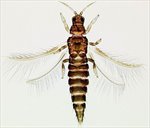
americanus Female
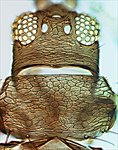
americanus head & pronotum

americanus antenna
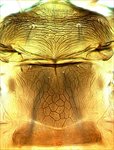
americanus meso & metanota

americanus tergites VI-X
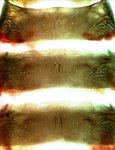
americanus tergites
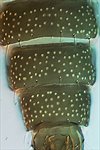
americanus male sternites

americanus maxillary palps

americanus fore wing
Generic diagnosis
Female macropterous. Head strongly reticulate, slightly prolonged in front of eyes; maxillary palps 3-segmented; eyes with seven pigmented facets; ocellar setae I present; three pairs of postocular setae. Antennae 8-segmented, segment I without paired dorso-apical setae, III and IV with sense-cones usually simple, III–VI with one to three rows of microtrichia. Pronotum strongly reticulate, with three pairs of capitate posteromarginal setae. Mesonotum reticulate; median pair of setae far from posterior margin, campaniform sensilla absent. Metanotum reticulate; median pair of setae far from anterior margin. Fore wings with first vein close to costal vein, both usually with continuous row of long capitate setae, second vein without setae; clavus with two veinal and one discal setae; posterior fringe cilia wavy. Prosternal ferna slightly divided medially; basantra membranous, without setae. Mesosternum with sternopleural sutures absent; endofurca with spinula; spinasternum very narrow. Metasternum endofurca without spinula. Tarsi 2-segmented. Tergites without ctenidia or craspeda, not clearly divided from pleurotergites; tergites II–VIII with S1 setae long and close together, lateral thirds usually with numerous ciliate microtrichia on sculpture lines; tergite VIII with posteromarginal comb long, fine and complete; IX with two pairs of MD setae, campaniform sensilla absent. Sternites without discal setae; III–VII with three pairs of posteromarginal setae, II with two pairs, all setae arise in front of posterior margin.
Male similar to female; sternites III–VIII with numerous small pore plates.
Biological data
The leaf-feeding thrips in this genus exhibit an unusual host range. One species is known to breed on a species of Pinaceae, one breeds on a species of Selaginella, but the others are associated with various dicotyledonous plants. The widely introduced species, americanus, is known particularly as a pest of cultivated Capsicum [Solanaceae] (Zhu et al., 2017).
Distribution data
The species of this genus are all from the Americas, with one species introduced widely around the world as a pest on some crops.
Nomenclatural data
Echinothrips Moulton, 1911: 37. Type species Echinothrips mexicanus Moulton, 1911, by monotypy.
This genus of seven species (ThripsWiki, 2020) includes one pest species that is introduced to China:
americanus Morgan, 1913: 14.
Relationship data
Thripidae sub-family Thripinae: this is a diverse group involving more than 230 genera. The species of Echinothrips share extensive reticulate sculpture with species of Panchaetothripinae. However, the chaetotaxy of the fore wings, with no setae on the second vein, suggest a possible relationship to the Sericothripinae (Lima & Mound, 2016).
References
Lima EFB & Mound LA (2016) Systematic relationships of the Thripidae subfamily Sericothripinae (Insecta: Thysanoptera). Zoologischer Anzeiger 263: 24–32.
Mound LA & Marullo R (1996) The Thrips of Central and South America: An Introduction. Memoirs on Entomology, International 6: 1–488.
ThripsWiki (2020) ThripsWiki - providing information on the World's thrips. <http://thrips.info/wiki/Main_Page>
Zhu L, Wang ZH, Gong YJ, Cao LJ & Wei SJ (2017) Effect of temperature on the development of Echinothrips americanus Morgan (Thysanoptera: Thripidae) with special reference to the number of generations. Journal of Asia-Pacific Entomology 20 (4): 1197–1203.